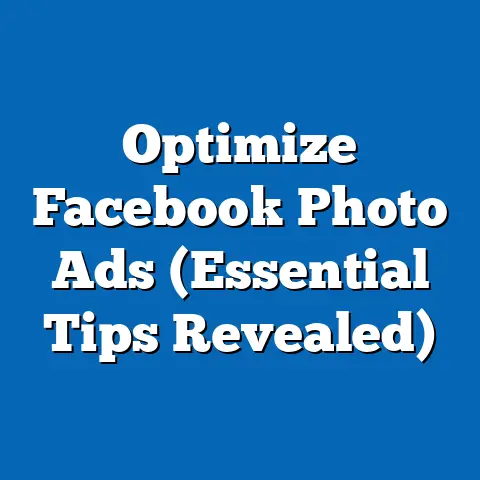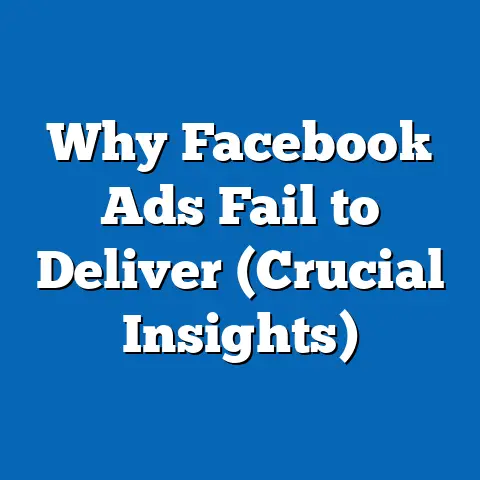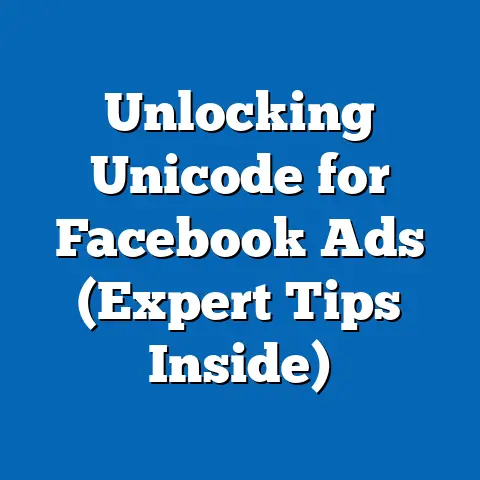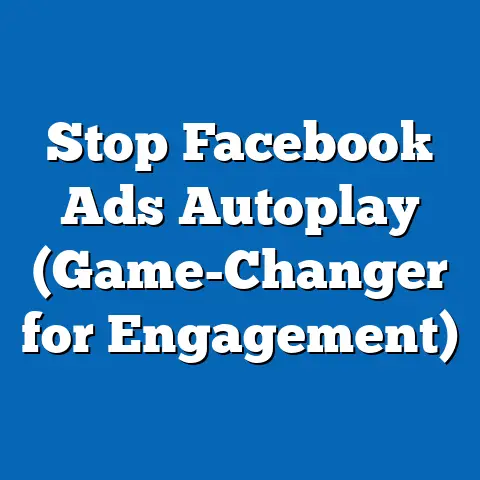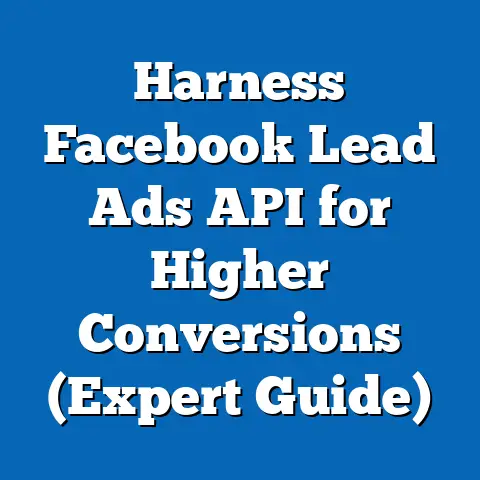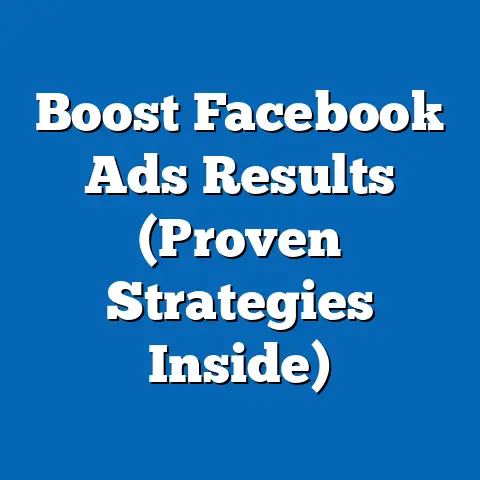Master Facebook Ads Settlements (Essential Strategies)
One myth I often encounter is that Facebook Ads are only effective for large businesses with massive budgets. This couldn’t be further from the truth! I’ve seen countless small and medium enterprises (SMEs) achieve remarkable results with well-planned and executed Facebook ad campaigns. The key isn’t just throwing money at the platform; it’s about understanding and mastering Facebook Ads settlements. By doing so, you can maximize your return on investment, regardless of the size of your budget. This guide is designed to equip you with the essential strategies you need to conquer Facebook Ads settlements and transform your advertising effectiveness.
Understanding Facebook Ads Settlements
Let’s begin by demystifying what “settlements” mean in the context of Facebook Ads. It’s not just about paying your bill at the end of the month. It’s a much broader concept that encompasses payment terms, ad delivery optimization, and understanding your billing cycles. Think of it as the entire lifecycle of your ad spend, from the moment you launch your campaign to the final invoice.
- Payment Terms: Facebook offers various payment options, including credit cards, debit cards, and PayPal. Understanding your payment terms is crucial for avoiding interruptions in your ad campaigns. Late payments can lead to your ads being paused, which can negatively impact your momentum and results.
- Ad Delivery Optimization: This is where Facebook’s algorithms come into play. They analyze your campaign goals, target audience, and ad creative to optimize delivery, ensuring your ads are shown to the most relevant users at the right time. This optimization directly impacts your ad costs and overall performance.
- Billing Cycles: Facebook typically bills you either when you reach a specific spending threshold or at the end of the month, whichever comes first. Knowing your billing cycle helps you track your ad spend and manage your budget effectively.
How Facebook Determines Ad Costs
Facebook’s ad costs are dynamic and influenced by several factors. Understanding these factors is essential for optimizing your campaigns and controlling your ad spend.
- Bidding Strategy: Your bidding strategy plays a significant role in determining your ad costs. As I’ll detail in the next section, different bidding strategies have different cost implications.
- Competition: The more advertisers targeting the same audience as you, the higher the competition and the higher the ad costs. This is especially true for highly sought-after demographics and interests.
- Audience Targeting: The specificity of your audience targeting can also impact ad costs. Broad targeting may result in lower costs per impression, but it may also lead to lower conversion rates. Conversely, highly specific targeting may increase costs but also improve relevance and conversions.
- Ad Quality and Relevance: Facebook rewards high-quality and relevant ads with lower costs and better placement. This means creating ads that resonate with your target audience and provide value to them.
- Time of Year: Ad costs can fluctuate depending on the time of year. For example, during the holiday season, competition increases, and ad costs tend to rise.
The Importance of Understanding Settlements
Understanding settlements isn’t just about avoiding late fees or managing your budget; it’s about making informed decisions that drive results.
- Budgeting and Forecasting: By understanding how Facebook determines ad costs and how your campaigns are performing, you can accurately budget and forecast your ad spend. This helps you allocate resources effectively and avoid overspending.
- Optimizing for ROI: Mastering settlements allows you to identify areas where you can optimize your campaigns for a better return on investment (ROI). This includes refining your targeting, improving your ad creative, and adjusting your bidding strategy.
- Avoiding Unexpected Costs: By closely monitoring your ad spend and understanding your billing cycles, you can avoid unexpected costs and stay within your budget. This is especially important for small businesses with limited resources.
Takeaway: Facebook Ads settlements are much more than just paying your bill. It’s about understanding the entire lifecycle of your ad spend and making informed decisions to optimize your campaigns for maximum ROI.
Choosing the Right Bidding Strategy
Your bidding strategy is the engine that drives your Facebook ad campaigns. Choosing the right strategy is crucial for achieving your desired results while staying within your budget. Facebook offers several bidding strategies, each with its own advantages and disadvantages.
- Cost Per Click (CPC): With CPC bidding, you pay each time someone clicks on your ad. This is a good option if your primary goal is to drive traffic to your website or landing page.
- Cost Per Mille (CPM): With CPM bidding, you pay for every 1,000 impressions your ad receives. This is a good option if your primary goal is to increase brand awareness or reach a large audience.
- Cost Per Action (CPA): With CPA bidding, you pay each time someone takes a specific action, such as making a purchase or filling out a form. This is a good option if your primary goal is to drive conversions.
- Cost Per View (CPV): With CPV bidding, you pay each time someone views your video ad. This is a good option if your primary goal is to increase video views or engagement.
Comparing Bidding Strategies
| Bidding Strategy | Advantages | Disadvantages | Best Use Cases |
|---|---|---|---|
| CPC | Direct control over costs, good for driving traffic | Can be expensive if click-through rate is low | Driving traffic to website, generating leads |
| CPM | Cost-effective for reaching a large audience, good for brand awareness | Can be ineffective if ads aren’t engaging, potential for wasted impressions | Brand awareness, reaching a large audience, promoting a new product or service |
| CPA | Pay only for desired actions, good for driving conversions | Requires accurate tracking and attribution, can be expensive if conversion rates are low | Driving sales, generating leads, acquiring new customers |
| CPV | Cost-effective for increasing video views, good for engagement | Can be ineffective if videos aren’t engaging, potential for wasted views | Increasing video views, driving engagement, promoting a brand through video content |
| Bidding Strategy | Advantages | Disadvantages | Best Use Cases |
|---|---|---|---|
| CPC | Direct control over costs, good for driving traffic | Can be expensive if click-through rate is low | Driving traffic to website, generating leads |
| CPM | Cost-effective for reaching a large audience, good for brand awareness | Can be ineffective if ads aren’t engaging, potential for wasted impressions | Brand awareness, reaching a large audience, promoting a new product or service |
| CPA | Pay only for desired actions, good for driving conversions | Requires accurate tracking and attribution, can be expensive if conversion rates are low | Driving sales, generating leads, acquiring new customers |
| CPV | Cost-effective for increasing video views, good for engagement | Can be ineffective if videos aren’t engaging, potential for wasted views | Increasing video views, driving engagement, promoting a brand through video content |
Setting a Budget That Aligns with Your Bidding Strategy
Setting a budget that aligns with your bidding strategy is crucial for maximizing your ROI. Here are some tips:
- Start Small and Test: Begin with a small budget and test different bidding strategies to see what works best for your business.
- Monitor Performance: Closely monitor your campaign performance and adjust your budget accordingly. If you’re seeing good results, you can increase your budget. If you’re not seeing results, you may need to adjust your bidding strategy or targeting.
- Consider Your Goals: Your budget should align with your overall marketing goals. If you’re trying to drive sales, you’ll need a larger budget than if you’re just trying to increase brand awareness.
- Use Facebook’s Budget Recommendations: Facebook provides budget recommendations based on your campaign goals and target audience. These recommendations can be a good starting point for setting your budget.
Takeaway: Choosing the right bidding strategy and setting a budget that aligns with your campaign goals are essential for maximizing your ROI on Facebook Ads.
Targeting the Right Audience
Audience targeting is the cornerstone of any successful Facebook ad campaign. It’s about ensuring that your ads are seen by the people who are most likely to be interested in your products or services. Without effective targeting, you’re essentially throwing money away, showing your ads to people who have no interest in what you have to offer.
The Importance of Audience Targeting
- Increased Relevance: By targeting the right audience, you increase the relevance of your ads. This leads to higher engagement rates, lower costs, and better results.
- Improved Conversion Rates: When your ads are seen by people who are genuinely interested in your products or services, your conversion rates will improve. This means more leads, more sales, and a better ROI.
- Reduced Ad Waste: Effective targeting reduces ad waste by ensuring that your ads are only shown to people who are likely to be interested. This saves you money and improves your overall campaign performance.
Targeting Options Available on Facebook
Facebook offers a wide range of targeting options, allowing you to reach your ideal audience with precision.
- Demographics: Target users based on age, gender, location, education, job title, and other demographic factors.
- Interests: Target users based on their interests, hobbies, and passions. Facebook gathers this information from users’ profiles, pages they like, and content they engage with.
- Behaviors: Target users based on their online and offline behaviors, such as purchase history, travel habits, and device usage.
- Custom Audiences: Create custom audiences based on your existing customer data, such as email lists, website visitors, and app users.
- Lookalike Audiences: Expand your reach by creating lookalike audiences based on your existing custom audiences. Facebook will identify users who share similar characteristics and behaviors with your existing customers.
Creating Detailed Buyer Personas
Creating detailed buyer personas is a crucial step in effective audience targeting. A buyer persona is a semi-fictional representation of your ideal customer, based on research and data about your existing customers.
- Gather Data: Collect data about your existing customers through surveys, interviews, and analytics.
- Identify Key Characteristics: Identify the key characteristics of your ideal customer, such as demographics, interests, behaviors, and pain points.
- Create a Persona Profile: Create a detailed profile for your buyer persona, including their name, age, occupation, interests, and motivations.
- Use Your Persona to Inform Targeting: Use your buyer persona to inform your Facebook ad targeting. Target users who share similar characteristics and behaviors with your ideal customer.
Leveraging Facebook’s Audience Insights Tool
Facebook’s Audience Insights tool provides valuable data about your target audience, helping you refine your targeting and improve your campaign performance.
- Access Audience Insights: Access Audience Insights through the Facebook Ads Manager.
- Explore Audience Demographics: Explore the demographics of your target audience, including age, gender, location, and education.
- Discover Audience Interests: Discover the interests and hobbies of your target audience.
- Analyze Audience Behaviors: Analyze the online and offline behaviors of your target audience.
- Use Insights to Refine Targeting: Use the insights you gain from Audience Insights to refine your Facebook ad targeting.
Takeaway: Targeting the right audience is essential for maximizing your ROI on Facebook Ads. By creating detailed buyer personas and leveraging Facebook’s Audience Insights tool, you can reach your ideal customer with precision and improve your campaign performance.
Crafting Compelling Ad Creative
While targeting is crucial, it’s only half the battle. Even the most perfectly targeted ad will fail if the creative is uninspired or irrelevant. Compelling ad creative is what grabs attention, sparks interest, and ultimately drives conversions. It’s the art and science of crafting ads that resonate with your target audience and persuade them to take action.
The Role of Compelling Ad Creative
- Grabbing Attention: In the crowded landscape of Facebook, your ad needs to stand out from the noise. Compelling ad creative is what grabs attention and makes users stop scrolling.
- Sparking Interest: Once you’ve grabbed their attention, you need to spark their interest. This means crafting a message that resonates with their needs, desires, and pain points.
- Driving Conversions: Ultimately, the goal of your ad is to drive conversions. Compelling ad creative is what persuades users to take action, whether it’s visiting your website, making a purchase, or filling out a form.
Best Practices for Ad Visuals
- Use High-Quality Images and Videos: Use high-quality images and videos that are visually appealing and relevant to your target audience.
- Showcase Your Products or Services: Showcase your products or services in a way that highlights their benefits and features.
- Use Eye-Catching Graphics: Use eye-catching graphics and animations to grab attention and make your ad stand out.
- Use Consistent Branding: Use consistent branding across all your ad visuals to reinforce your brand identity.
Best Practices for Copywriting
- Write Clear and Concise Copy: Write clear and concise copy that is easy to understand and gets straight to the point.
- Highlight the Benefits: Highlight the benefits of your products or services, rather than just listing the features.
- Use Emotionally Compelling Language: Use emotionally compelling language that resonates with your target audience’s needs, desires, and pain points.
- Tell a Story: Tell a story that engages your target audience and makes them feel connected to your brand.
Best Practices for Calls-to-Action (CTAs)
- Use Clear and Actionable CTAs: Use clear and actionable CTAs that tell users exactly what you want them to do.
- Make CTAs Prominent: Make your CTAs prominent and easy to find.
- Use Urgency and Scarcity: Use urgency and scarcity to encourage users to take action immediately.
- A/B Test Your CTAs: A/B test different CTAs to see which ones perform best.
Examples of Successful Ad Campaigns
- Dollar Shave Club: Dollar Shave Club’s humorous and relatable ad campaigns have helped them build a loyal customer base and disrupt the shaving industry.
- Airbnb: Airbnb’s ad campaigns focus on showcasing unique travel experiences and connecting travelers with local hosts.
- Nike: Nike’s ad campaigns are known for their inspiring and motivational messaging, which resonates with athletes of all levels.
Takeaway: Compelling ad creative is essential for grabbing attention, sparking interest, and driving conversions on Facebook Ads. By following best practices for ad visuals, copywriting, and CTAs, you can create ads that resonate with your target audience and achieve your desired results.
Analyzing Performance and Making Data-Driven Decisions
You’ve launched your campaigns, crafted killer creative, and targeted your ideal audience. But the work doesn’t stop there. In fact, it’s just beginning. Monitoring your ad performance and making data-driven decisions is crucial for optimizing your campaigns and maximizing your ROI. It’s about understanding what’s working, what’s not, and making adjustments to improve your results.
The Importance of Monitoring Ad Performance Metrics
- Identifying Areas for Improvement: Monitoring ad performance metrics helps you identify areas where you can improve your campaigns. This includes refining your targeting, improving your ad creative, and adjusting your bidding strategy.
- Optimizing for ROI: By tracking your key performance indicators (KPIs), you can optimize your campaigns for a better return on investment (ROI).
- Making Informed Decisions: Data-driven decision-making allows you to make informed decisions about your ad spend and campaign strategy.
Key Performance Metrics to Track
- Click-Through Rate (CTR): The percentage of people who see your ad and click on it. A high CTR indicates that your ad is relevant and engaging to your target audience.
- Conversion Rate: The percentage of people who click on your ad and complete a desired action, such as making a purchase or filling out a form. A high conversion rate indicates that your landing page is effective and your offer is compelling.
- Cost Per Click (CPC): The amount you pay each time someone clicks on your ad. A low CPC indicates that your ad is efficient and cost-effective.
- Cost Per Acquisition (CPA): The amount you pay to acquire a new customer or lead. A low CPA indicates that your campaign is effective at driving conversions.
- Return on Ad Spend (ROAS): The amount of revenue you generate for every dollar you spend on advertising. A high ROAS indicates that your campaign is profitable and generating a good return on investment.
Using Facebook Ads Manager to Analyze Metrics
Facebook Ads Manager provides a wealth of data and analytics to help you monitor your ad performance.
- Access Ads Manager: Access Ads Manager through your Facebook business page.
- Customize Your Columns: Customize the columns in Ads Manager to display the metrics that are most important to you.
- Filter and Segment Your Data: Filter and segment your data to analyze performance by campaign, ad set, and ad.
- Use Reporting Tools: Use Facebook’s reporting tools to create custom reports and visualize your data.
A/B Testing for Optimization
A/B testing, also known as split testing, is a powerful technique for optimizing your ad performance. It involves creating two versions of an ad (A and B) and testing them against each other to see which one performs better.
- Test Different Elements: Test different elements of your ads, such as headlines, images, copy, and CTAs.
- Isolate Variables: Isolate one variable at a time to ensure that you’re accurately measuring the impact of each element.
- Use a Control Group: Use a control group to compare your test results against a baseline.
- Analyze Results and Implement Changes: Analyze the results of your A/B tests and implement changes based on your findings.
Takeaway: Monitoring your ad performance and making data-driven decisions is crucial for optimizing your campaigns and maximizing your ROI on Facebook Ads. By tracking key performance metrics, using Facebook Ads Manager to analyze your data, and A/B testing different elements of your ads, you can continuously improve your results and achieve your desired outcomes.
Staying Compliant with Facebook Policies
Navigating Facebook’s advertising policies is like walking a tightrope. One wrong step, and your ads could be disapproved, or worse, your account could be suspended. It’s crucial to understand and adhere to these policies to avoid any disruptions to your campaigns and maintain a positive relationship with Facebook.
The Importance of Adhering to Facebook’s Advertising Policies
- Avoiding Ad Disapproval: Adhering to Facebook’s policies helps you avoid ad disapproval, which can delay your campaigns and waste your time.
- Preventing Account Suspension: Repeated violations of Facebook’s policies can lead to account suspension, which can severely impact your ability to advertise on the platform.
- Maintaining a Positive Relationship with Facebook: By following Facebook’s policies, you demonstrate that you’re a responsible advertiser and maintain a positive relationship with the platform.
Common Pitfalls That Lead to Policy Violations
- Misleading or Deceptive Claims: Avoid making misleading or deceptive claims about your products or services.
- Sensational or Shocking Content: Avoid using sensational or shocking content that could be offensive or disturbing to users.
- Personal Attributes: Avoid referencing personal attributes, such as race, ethnicity, religion, or sexual orientation, in your ads.
- Health and Medical Claims: Avoid making unsubstantiated health and medical claims about your products or services.
- Prohibited Products and Services: Avoid advertising products and services that are prohibited by Facebook, such as illegal drugs, weapons, and tobacco.
Tips for Creating Compliant Ads
- Read and Understand the Policies: Take the time to read and understand Facebook’s advertising policies.
- Review Your Ads Carefully: Review your ads carefully before submitting them to ensure that they comply with the policies.
- Use Facebook’s Policy Checker: Use Facebook’s policy checker to identify potential violations before submitting your ads.
- Stay Up-to-Date: Stay up-to-date on any changes to Facebook’s advertising policies.
Takeaway: Adhering to Facebook’s advertising policies is crucial for avoiding ad disapproval, preventing account suspension, and maintaining a positive relationship with the platform. By understanding the policies, avoiding common pitfalls, and creating compliant ads, you can ensure that your campaigns run smoothly and achieve your desired results.
Scaling Your Campaigns for Greater Success
You’ve mastered the fundamentals, optimized your campaigns, and achieved impressive results. Now it’s time to take things to the next level and scale your campaigns for greater success. Scaling involves expanding your reach, increasing your budget, and leveraging advanced techniques to drive even more conversions.
Strategies for Scaling Successful Campaigns
- Increasing Budgets: Gradually increase your budgets to reach a larger audience and drive more conversions.
- Expanding Audience Reach: Expand your audience reach by targeting new demographics, interests, and behaviors.
- Leveraging Retargeting: Retarget users who have previously interacted with your website or ads to re-engage them and drive conversions.
The Concept of Lookalike Audiences
Lookalike audiences are a powerful tool for scaling your Facebook ad campaigns. They allow you to reach new users who share similar characteristics and behaviors with your existing customers.
- Create a Source Audience: Create a source audience based on your existing customer data, such as email lists, website visitors, and app users.
- Create a Lookalike Audience: Create a lookalike audience based on your source audience. Facebook will identify users who share similar characteristics and behaviors with your source audience.
- Target Your Lookalike Audience: Target your lookalike audience with your Facebook ads.
When and How to Scale
- When You’re Seeing Positive Results: Scale your campaigns when you’re seeing positive results, such as high CTRs, conversion rates, and ROAS.
- Gradually Increase Your Budget: Gradually increase your budget to avoid overspending or diminishing returns.
- Monitor Performance Closely: Monitor your performance closely as you scale your campaigns to ensure that you’re still achieving your desired results.
Takeaway: Scaling your Facebook ad campaigns can help you reach a larger audience, drive more conversions, and achieve greater success. By increasing budgets, expanding audience reach, leveraging retargeting, and utilizing lookalike audiences, you can take your campaigns to the next level and achieve your business goals.
Conclusion
Mastering Facebook Ads settlements is not just about understanding the technical aspects; it’s about understanding the nuances of the platform, the psychology of your audience, and the art of crafting compelling messages. It’s a continuous process of learning, testing, and optimizing. By implementing the strategies I’ve discussed throughout this article, you can enhance your advertising effectiveness, achieve your business goals, and transform your Facebook ad campaigns from cost centers into profit engines. So, take action, experiment with these strategies, and unlock the full potential of Facebook Ads for your business. The power to transform your advertising results is now in your hands!

